Stogie Spirits: Goose Island Harvest Ale
1 Oct 2008
Ever since I moved to Chicago, certain things in my life have been quite unpredictable. Take the weather, for instance. One week it’s hot and muggy; the next it’s pouring rain and…still hot and muggy. Now things are starting to cool down, which is nice—but it’s like the calm before the storm. I know the worst is ahead of me, and I’m bracing for winter’s impact in the naïve, foolishly self-assured way that only a spoiled California boy can.
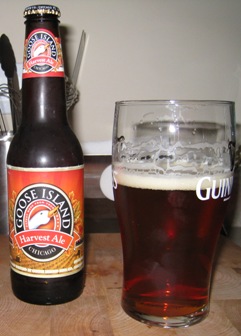 In these times of peril, I turn to the few things I know will always be constant. One of those things is beer. I don’t care if it’s hot, cold, wet, or dry outside, beer is always seasonally appropriate. And so, I figure, what better way to greet my first fall and winter in the Midwest than to sample some of the local brew?
In these times of peril, I turn to the few things I know will always be constant. One of those things is beer. I don’t care if it’s hot, cold, wet, or dry outside, beer is always seasonally appropriate. And so, I figure, what better way to greet my first fall and winter in the Midwest than to sample some of the local brew?
Goose Island Harvest Ale is an autumn-appropriate microbrew from Chicago-based craft brewery Goose Island. I’ll admit to never having heard of Goose Island before my arrival here. But that’s changed very quickly. This brand comes highly recommended from friends in the area, and it’s easy to see why: Goose Island Harvest Ale is a complex, but unpretentious beer that’s an obvious cut above the usual suspects on tap at your local bar.
This deep copper ale poured cleanly and smoothly into my ceremonial Guinness pint glass, leaving a creamy, inch-and-a-half-thick head with lots of lacing around the rim. The nose is mostly floral, with pronounced but pleasant notes of grapefruit and hops. There’s lots of citrus—particularly grapefruit, but some orange peel is also detectable—in the flavor profile, rounded out with hoppy bitterness and a sweet, malty finish.
Admittedly, I haven’t had the occasion to pair this beer with a decent smoke just yet. But when I do, I think it’ll go nicely with a mild to medium-bodied cigar—nothing too bold, but something that will stand up to the big flavors the drink brings to the table. I look forward to experimenting with pairings in the cold, bitter weeks to come.
photo credit: Stogie Guys

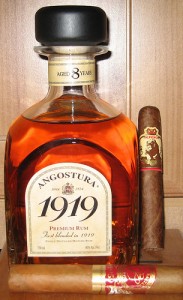 Oddly enough, this Trinidad & Tobago-based company is better known for its aromatic bitters—highly concentrated food and beverage flavorings—than its rum. Angostura’s beginnings can be traced back to 1824 when a surgeon general in
Oddly enough, this Trinidad & Tobago-based company is better known for its aromatic bitters—highly concentrated food and beverage flavorings—than its rum. Angostura’s beginnings can be traced back to 1824 when a surgeon general in  But the Balvenie Doublewood isn’t an ordinary scotch. Halfway through the twelve-year distilling process the scotch is transferred from one barrel to another, hence “Doublewood,” as explained on Balvenie’s
But the Balvenie Doublewood isn’t an ordinary scotch. Halfway through the twelve-year distilling process the scotch is transferred from one barrel to another, hence “Doublewood,” as explained on Balvenie’s 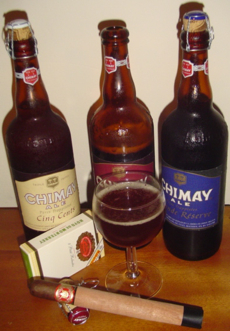 In my opinion, beer often doesn’t get a fair shake as a pairing with cigars. Perhaps this is because many Americans think of the watery, unflavorful beers that we see marketed on television, overlooking the many hand-crafted, flavorful beers that are widely available to consumers.
In my opinion, beer often doesn’t get a fair shake as a pairing with cigars. Perhaps this is because many Americans think of the watery, unflavorful beers that we see marketed on television, overlooking the many hand-crafted, flavorful beers that are widely available to consumers.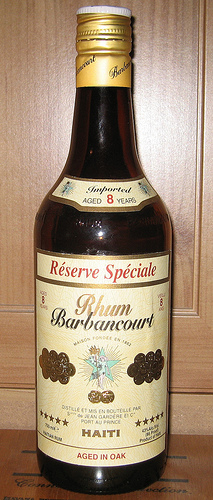 Barbancourt has amassed an impressive array of 22 medals since the family business was established in Haiti in the 1860s, most recently a Santé Gold Star Award in 2006. Here’s a bit of history from the label’s
Barbancourt has amassed an impressive array of 22 medals since the family business was established in Haiti in the 1860s, most recently a Santé Gold Star Award in 2006. Here’s a bit of history from the label’s 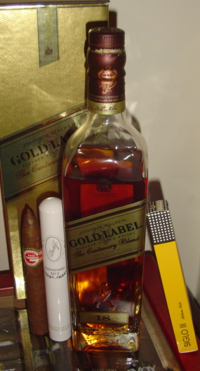 Like the Blue Label, the Gold is a blended scotch made with some of the most exclusive single malts Scotland has to offer. Originally created by Sir Alexander Walker in 1920 to celebrate 100 years of the Johnnie Walker brand, the Gold Label is comprised of at least 15 different single malts, all at least 18 years old and some many years older (although reportedly the Gold blend is sometimes bottled with the youngest scotches being 15 years in age).
Like the Blue Label, the Gold is a blended scotch made with some of the most exclusive single malts Scotland has to offer. Originally created by Sir Alexander Walker in 1920 to celebrate 100 years of the Johnnie Walker brand, the Gold Label is comprised of at least 15 different single malts, all at least 18 years old and some many years older (although reportedly the Gold blend is sometimes bottled with the youngest scotches being 15 years in age).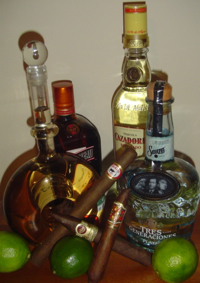 4. Stir with ice
4. Stir with ice Patrick Ashby
Co-Founder & Editor in Chief
Patrick Ashby
Co-Founder & Editor in Chief Patrick Semmens
Co-Founder & Publisher
Patrick Semmens
Co-Founder & Publisher George Edmonson
Tampa Bureau Chief
George Edmonson
Tampa Bureau Chief